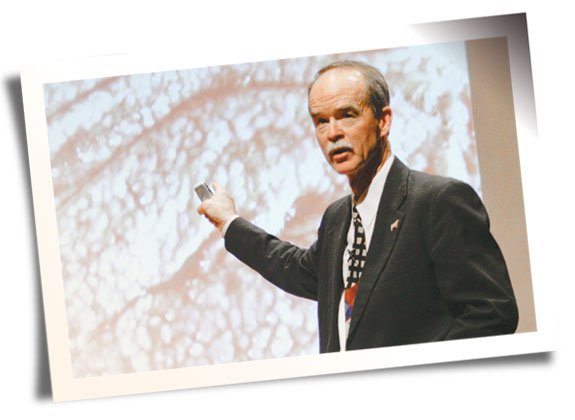
Over a period of three decades, the livestock agriculture industry has experienced several factors changing its profitability and operations.
Jeff Mosley, a beef specialist with Montana State University, pointed to three factors – cheap corn, cheap oil and cheap money for the U.S. – as contributors to the nation’s expectation of cheap food.
All of those dynamics are expected to change in coming years – if they haven’t already.
Volatility in oil production, ethanol subsidies and rising corn costs, and the declining value of the U.S. dollar, all have direct influence on beef prices and livestock production.
As a result, food production costs are expected to rise over the next decade.
That dynamic will make rangeland more critical to food production, Mosley said. The environmental movement’s grip on rangeland could shift to more of a conservation philosophy.
With higher costs of food production, consumers and politicians are likely to encourage more rangeland use for livestock raised for beef production.
“You don’t have much time to ponder how to preserve that tree if you’re freezing at night,” Mosley said. “When you have lots of cheap food, you don’t consider using that land for producing food.”
Demand factors will also rise as the world population continues to climb from 6.5 billion people today, to between 9 and 10 billion by 2050; the challenge to be met is how to balance crops used for biofuels and those going into the food cycle.
And oil production will have peaked long before then. This could all put the corn-based beef production method at much higher costs.
“If that’s true, that has major implications to rangeland livestock industries,” Mosley said.
Barry Perryman, professor of animal science at University of Nevada – Reno, also outlined factors that rangeland livestock producers must battle in their grazing practices with a growing segment of urban consumers.
Perryman cited statistics showing that it takes most Americans 36 days to earn enough disposable income to pay for their food consumption for that entire year.
But it takes 52 days to earn income for health care, 62 days for housing and 77 for federal taxes.
“U.S. people are not typically concerned about the supply of high-quality/low-cost agricultural products,” he said. “And why? Because it’s cheap and easy to get a hold of.”
Technology’s place in the beef industry
When technology is mentioned for computers, medicine or media, it is roundly applauded by society.
But when a breakthrough is made in livestock production, technology is unfairly labeled a factory-farming ploy that’s harmful to the consumer, said Gary Sides, a beef cattle nutritionist for Pfizer Animal Health.
Producers should avidly defend the technology made in ag science that leads to efficiency and fewer expendable resources, Sides said.
From the polio vaccine to Dr. Norman Borlaug’s Nobel Prize-winning work with genetically modified grain, technology has saved lives, and in ag’s case – fed the entire world.
But producers still have a ways to go in embracing technological advances.
“Folks, we have forgotten heterosis,” Sides said, noting how the majority of cattle are now black-hided. “We have forgotten cross-breeding’s longevity of the cow, (and) performance in the feedlot.”
A cross-bred calf will have “an 80 dollar bill attached to it over the straight bred of either breed you cross it with. And we’ve forgotten it.”
Synchronization is likewise a procedure that saves money and labor, but hasn’t caught on with producers.
“Brazil buys three times more doses of beef semen than we do and they’re a third-world country. There are techniques to synchronize heifers where I get 70 percent bred first-service conception rate … and we don’t use it.”
Growth enhancement technology and implants are tools commonly criticized by those outside ag.
But Sides called the science extremely useful since it reduces the land required to produce a pound of beef, as well as greenhouse gas emissions cited by environmental critics.
Comparing implanted cattle to that which hasn’t been implanted has shown no great price comparisons on auction sites and university studies, Sides said.
“There is a difference if you have a signed contract with someone who says they’re going to buy your non-implanted cattle. And that’s great – fill that niche. But make sure they pay you what it’s worth not to use implants and ionophores in antibiotics.
If I go from 500-pound calf to 1,200-pound finish weight on a hormone-free antibiotic-free program, you need 150 dollars a head just to break even. Make sure you get that.”
Sides called parasite controls “the number one technology we have in our business, across all the different technologies, from cow-calf to the feedlots.
“When I kill parasites, conception rates, weaning rates, carcass qualities, and feed efficiency, it is huge. It’s our number one technology, more so than anything else, from cow-calf operations to feedlot operations.
I get my greatest bang for a dollar investing in killing parasites, because of their effect on feed intake.” ![]()
PHOTOS
TOP: Gary Sides of Pfizer Animal Health addresses the changing science that has improved herd health and beef production.
BOTTOM: Barry Perryman of University of Nevada – Reno said the changing urban dynamic is a constant theme in veterinary education and beef grazing. Photos by David Cooper






